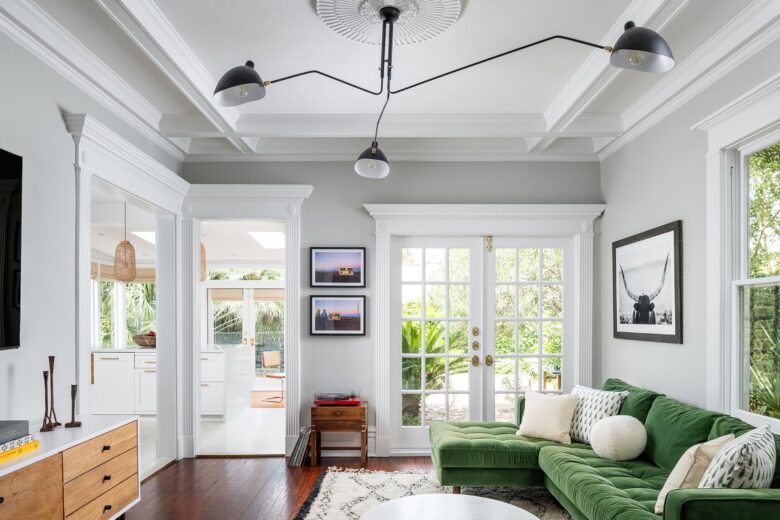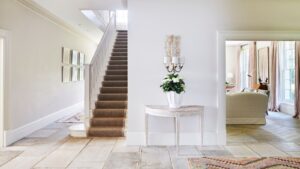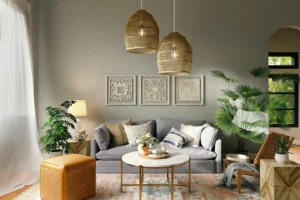Why Start with DIY Home Fixes?
Giving your home a fresh look doesn’t require a contractor or a huge budget. In fact, with just a few tools and a little creativity, you can make meaningful improvements room by room. DIY projects are a great way to personalize your space, fix small issues, and add charm—all while gaining confidence in your home improvement skills. Whether you’re completely new to DIY or just looking for simple upgrades, these fixes are manageable and rewarding.
Living Room: Refresh with Paint and Lighting
The living room is often the most-used space in any home, so small improvements here can make a big difference. Start by giving the walls a fresh coat of paint. Soft neutral colors can make the space feel larger and brighter, while a bold accent wall can bring personality and depth. If painting sounds intimidating, try a peel-and-stick wallpaper feature behind your couch or TV stand.
Swapping out outdated lighting is another easy win. Install a new ceiling fixture, or add floor and table lamps for a cozy layered lighting effect. Plug-in sconces offer a designer touch without hardwiring, and battery-powered puck lights work wonders in bookshelves or under cabinets.
Kitchen: Upgrade Hardware and Add a Backsplash
The kitchen is a high-impact room when it comes to home value. Fortunately, simple DIY upgrades can give it a refreshed, modern look. Replacing old cabinet knobs and drawer pulls is as easy as using a screwdriver. Choose new hardware in modern finishes like matte black, gold, or brushed nickel to match your desired look.
For an eye-catching improvement, try a peel-and-stick tile backsplash. These are designed for beginners, require no grout or special tools, and can be installed in a single afternoon. If your budget allows, consider replacing your faucet with a stylish, high-arc model that’s both functional and visually appealing.
Bathroom: Update Fixtures and Frame the Mirror
Bathrooms are another space where beginner-friendly DIY can go a long way. Start by updating your faucet and showerhead. Most models are designed for easy installation with common tools. Choose water-efficient options to save on utility bills while upgrading style.
Another quick and impactful project is framing your builder-grade bathroom mirror. You can use pre-cut trim or molding and attach it with adhesive directly onto the glass. Finish with paint or stain to match your décor. Add some fresh caulking around the sink or tub for a clean, polished finish.
Bedroom: Create a Statement Wall and Add Storage
The bedroom should feel restful and personal. Begin by creating a statement wall behind your bed. Use peel-and-stick wallpaper, wall decals, or a simple painted arch or stripe to add interest. For a cozy touch, hang string lights or a fabric canopy.
Next, maximize your storage. Install floating shelves above your dresser or near your closet for books, plants, or personal items. Use under-bed storage bins or slide-in drawers to make the most of unused space. You can even build a simple headboard with plywood, foam, and fabric—no sewing required.
Entryway: Make a Functional First Impression
Your entryway sets the tone for your home. One easy project is creating a DIY drop zone with wall hooks, a small bench, and a few baskets. Use peel-and-stick wall tiles or beadboard panels for a decorative and protective wall treatment.
Upgrade your welcome with a new doormat and consider painting your front door a bold color. If you have room, add a mirror or shelf for keys and small essentials. These small touches make coming home more enjoyable and welcoming to guests.
Home Office: Build a Desk and Organize Cables
With more people working from home, having a functional and inspiring office space is essential. Build your own desk using a pre-cut countertop and two filing cabinets or storage units as supports. It’s a low-cost, high-impact way to create a custom workstation.
To clean up visual clutter, use adhesive clips or a cable management box to organize cords and chargers. Paint or decorate a corkboard for organizing notes, or install floating shelves to display inspiring items without taking up desk space.
Laundry Room: Add Storage and Brighten the Space
Laundry rooms are often neglected but benefit greatly from a little love. Install wall-mounted shelves or cabinets above your washer and dryer to store supplies. Use labeled baskets to keep items organized. A tension rod for hang-drying clothes can also be added in minutes.
Brighten the room by painting it a cheerful color or adding peel-and-stick floor tiles for a dramatic visual upgrade. If space allows, hang a folding station or attach a pull-down ironing board to the wall.
Kids’ Room: Make It Fun and Functional
In a child’s room, your goal is to balance fun with practicality. Paint a chalkboard wall or section using chalkboard paint so your child can draw directly on the wall. Add colorful bins and shelves within reach for easy clean-up and toy organization.
You can also personalize the space with wall art or name decals. If your child loves reading, create a book nook with a few floor cushions and a low bookshelf. All of these upgrades are beginner-friendly and help make the space more usable and enjoyable.
Outdoor Space: Improve Curb Appeal and Function
You don’t need a full backyard makeover to improve your home’s exterior. Start with simple tasks like planting flowers, repainting the front door, or installing solar-powered lights along a walkway. A welcome sign, new house numbers, or a DIY wreath can add personality to your entrance.
If you have a porch or patio, create a cozy seating area using inexpensive outdoor cushions and DIY planters. String lights can be hung for a charming evening ambiance, and a small side table or outdoor rug adds comfort and style.
Conclusion: Start Small, Build Confidence
You don’t need to be a contractor to make your home more beautiful, functional, and personal. By taking on simple, beginner-friendly DIY projects room by room, you can gain experience, improve your environment, and increase your home’s overall value. Start with one small project this weekend—you’ll be surprised how rewarding it feels to make a space your own.
Frequently Asked Questions (FAQ)
Q1: I’m new to DIY. What’s a good first project to try?
A great beginner DIY project is swapping out cabinet hardware or installing peel-and-stick wallpaper. These require minimal tools and instantly refresh a room without needing advanced skills.
Q2: Do I need expensive tools for DIY home fixes?
No. Most beginner projects only require basic tools like a screwdriver, measuring tape, level, and possibly a hammer or drill. Many home improvement stores offer tool rental services if needed.
Q3: Can I really paint a room by myself?
Yes! Painting is one of the most beginner-friendly projects. Just prep the surface, use painter’s tape for clean edges, and follow simple painting techniques. It’s affordable and highly transformative.
Q4: How can I make a small room feel bigger without remodeling?
Use lighter paint colors, add mirrors to reflect light, declutter surfaces, and opt for multi-functional furniture. Proper lighting also helps make a space feel more open.
Q5: What type of DIY project adds the most value to my home?
Simple upgrades in kitchens and bathrooms—like installing new faucets, backsplashes, or lighting—often deliver the highest return on investment. Curb appeal enhancements like painting the front door and landscaping also boost value quickly.
Q6: Are these DIY fixes renter-friendly?
Many of them are! Removable wallpaper, plug-in lighting, peel-and-stick tiles, and freestanding shelves can all enhance your space without making permanent changes.
Q7: How do I stay safe while working on DIY projects?
Always follow the instructions for tools and products, wear safety gear like gloves or goggles when needed, and ensure you’re working in a well-ventilated area—especially when painting or using adhesives.



